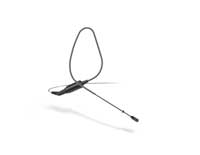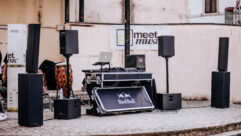

Sennheiser Ear Set 1 Headworn Mic Review
Mar 15, 2012 4:20 PM,
Reviewer: John McJunkin
A discreet, comfortable mic that delivers high-quality audio.
I wear a lot of hats as an audio professional, and I work across a moderately broad span of scenarios. In recent years, I have been charged with tasks ranging from the responsibility for filling a big room with tiny children’s voices to capturing and delivering the voices of congressional and presidential candidates for both public oratory and video interview. More often, I find myself between these two extremes, but I always approach the application with the same philosophy of choosing the right tool for the job and using it in the best possible way to deliver high-quality results.
When someone takes to the stage to speak to an audience of any kind, the professional audio engineer will very likely narrow his or her microphone choices down to a lavalier or headworn mic. I’ll lean toward a lav mic for video interviews during which I can be reasonably sure that the subject’s head will not be moving significantly; lav mics can be kept very discreet, if not outright invisible. If there is no camera involved, my palate will broaden out to include headworn mics, particularly if my subject will be on stage and moving around. ]
When the speaker is animated, a solution that keeps the microphone element in consistent proximity to his or her mouth is important. Three other major factors figure in here: aesthetics, audio quality, and comfort level for the speaker. Short of using a very discreet lavalier mic, I still want to keep the mic as inconspicuous as possible. Of course I want great sound too, but I’ll also want my speaker to be happy with the mic—they’ll be up close and personal with it for a while—they need to be comfortable. I evaluated Sennheiser’s Ear Set 1 ear-worn microphone bearing these criteria in mind, and I was frankly thrilled.

Upon unboxing the Ear Set 1 mic, I was immediately and very pleasantly surprised with three things: the small physical size of the overall earpiece/boom structure, the very slender boom and mic element diameters (1.1mm and 3.3mm, respectively), and the wispy thin cable. The entire structure is not only physically small, but a challenge to see from even a modest distance, making this mic truly inconspicuous. In addition to the black version sent to me for evaluation, the mic is also available in beige, making it even more discreet.
The Ear Set 1 ships with two frequency response caps, both of which boost the “air” frequencies up around 12-13kHz—the smaller one more so than the larger. The larger cap attenuates wind noise by about 15dB and affords greater protection of the mic element from moisture. Even with the larger cap, the mic and supporting structure are still visually understated. From an aesthetic standpoint, this mic is as good as any I’ve seen. The components of the mic are individually small, and the package as a whole is also small and not easily seen, particularly when using the beige version.
I connected the mic via the MZA 900P-4 inline preamp module, which also converts the mic’s output from its three-pin LEMO connector. The Ear Set 1 is an omnidirectional condenser mic, and the MZA module also delivers the phantom power from the user’s pre-amp or mixer necessary to provide the condenser element with current. Of course, Sennheiser’s wireless transmitters can also power the mic, and it can also be used with other manufacturers’ transmitters, but only with custom wiring. For example, Sennheiser does not make connectors available for Audio-Technica transmitters. If the element can be brought into close proximity with the speaker’s mouth, which is precisely the goal of the ear-worn structure, very little gain is necessary to get a solid, clear signal, and the likelihood for feedback is vastly reduced. Indeed, I was able to get good gain before feedback by taking some care to ensure that the mic element was placed in tight proximity to the mouth. Sennheiser includes hypoallergenic tape to facilitate really close location and security of the mic. The tape can be covered with make-up for stage production.
The Ear Set 1’s element is based on Sennheiser’s excellent MKE 1 lavalier mic, and it delivers the same exceptional quality. The frequency response is published as 20Hz-20kHz, ±3dB, with the largest deviation from a perfectly flat response in the form of a boost in the air frequencies, which can be enhanced with the caps. I tend to scoop mids to avoid nasal “honkiness” with nearly every head-worn mic I use, and this mic was no exception, only I found that I did not need to scoop nearly as much as with certain others. I had heard from colleagues that the MKE 1 lav was capable of delivering a signal that rivaled handheld mics, and now having heard this capsule, this has been confirmed for me. The mic truly sounds excellent, and it can take up to 143dB SPL, and frankly, it’s very unlikely that anything approaching 143dB SPL is going to happen in proximity to an ear-worn microphone. The mic is also quiet, with an equivalent noise level of 27dB—virtually inaudible to nearly all audiences and probably even to some professionals.
Much in the same way that the mic is visually subtle due to its small size, it’s also comfortable for similar reasons. It’s very lightweight, so does not “wear heavy” after lengthy stints with the mic in place. The slender, silicon-wrapped ear surround is also comfortable, and it does not squeeze the ear with undue pressure. It can also be shaped to the user’s ear, another welcome plus. And again, owing to the mic’s small physical size, it does not contribute to the feeling of a large, bulky attachment dangling off the user’s ear. And even without employing the included hypoallergenic tape, I was able to get the mic securely placed on both left and right ears of several test subjects. That feeling of having the mic securely in place contributes to the overall sense of comfort.
I have evaluated quite a number of ear-worn microphones over the years, formally and informally, so I feel like I’m not going out on a limb to say that this mic is simply as good as it gets in terms of ear-worn condenser mics. I would definitely recommend it to anyone who needs great audio quality, visual subtlety, and user comfort. It will now be high on my short list when people ask my advice.
Product Summary
Pros: Aesthetically discreet, comfortable mic that delivers excellent audio quality.
Cons: Custom wiring necessary for use with other manufacturers’ wireless transmitters.
Applications: Primarily stage and broadcast.
Price: $419.95
Specifications
Frequency response: 20Hz – 20kHz (±3dB)
Polar pattern: Omnidirectional
Impedance: 1kΩ
Sensitivity (in free field): 5mV/Pa ± 2.5dB (at 1kHz)
Diameter (mic element): 3.3mm
Maximum SPL (passive): 143dB
Equivalent noise level: 27dB
Current consumption: 240μA
Operating voltage: 4.5V-15V
Operating temperature: –10°C up to +50°C
Cable length: 1.6 meters
Diameter (boom arm): 1.1mm
Weight (w/o cable): 2.3g
John McJunkin is the principal of Avalon Podcasting in Chandler, Ariz. He has consulted in the development of studios and installations and provides high-quality podcast-production services.










